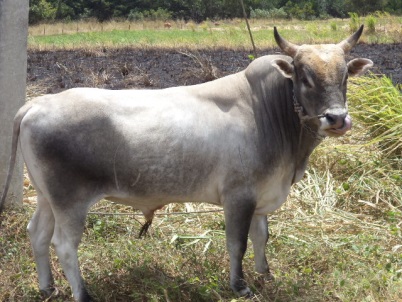
October 6, 2014. Adventures in New Jaipur, Prabhupadanuga Farm in Fiji
FIJI ELECTIONS
Democratic elections have been successfully concluded in Fiji, and international observers say there was no fraud or improprieties. Military man Bainimarama, who led the 2006 coup in objection to racist policies and corruption, ran as a civilian against 5 other parties and secured 60% of the vote. He proved himself as a popular “get-it-done” leader, virtually eliminating the racist mentality that had left the 42% Indian-origin citizens in a disadvantaged position.

Almost all Indians voted for Bainimarama, whose name is transcendentally auspicious (Rama). International pressure and sanctions after the 2006 coup have now been removed and only a minority of indigenous Fijians retain grudges, as Fiji looks forward to a new future of harmony amongst its diverse ethnic and religious groups. Widespread criticism of his 8 year military dictatorship has evaporated as he delivered what he promised- a better Fiji for all. Bainimarama has shown himself to be honest, equal, an unusually effective leader with high character. He is close friends with the Punjas family, the first disciples of Srila Prabhupada in Fiji, and fearlessly corrected the powerful Methodist Church which was implicated in racist politics.
He also exposed former leaders Chaudry and Qarase in corruption, resulting in convictions and exclusion from further politics. There were several attempts and plots on his life, but by the will of the Supreme, he has survived all opposition and now leads a 50 member parliament, facing the toughest challenge yet that is more or less beyond his influence- the deteriorating world financial system. Bainimarama has introduced free education, free medical services, one man/ one-vote, better roads, new housing, bans on racial barriers, better management of native lands (92% of country), and the end of the indigenous Great Council of Chiefs (arguing it promoted elitism for native Fijians). The country’s economy has come a long way since 2006. With Western allies isolating Fiji, Bainimarama has made new allies. Roads, hospitals and water projects have been built with Chinese money, while Fiji has turned to Russia to help outfit its army. Growth in 2013 was 4.6% and business confidence is near a record high. Still, 31% of people in Fiji continue to live below the poverty line, many in squatter settlements or native villages where life is simple.
Of course, all this political analysis is on the mundane platform, but the situation is more balanced, stable, and peaceful than before, and Fiji is a wonderful place to practice Krishna consciousness. Fiji is favorable for Vedic villages, due to the political landscape, local hospitality and friendliness, tropical climate, and pristine South Seas purity. Also there has been a marked turn away from socialism to a free market.
HIGH SPEED INTERNET COMES TO NEW JAIPUR
Digicel Fiji, a cellphone service provider owned by the world’s richest man in Mexico (Carlos Slim), has just ungraded their island-wide towers to 3G in competition to Vodaphone, who is partially 3G. New Jaipur farm is 15 km from a Digicel tower, and now receives high-speed internet service via phone signal and a F$59 modem-dongle, with about 3 GB /F$25 US$13). This is inexpensive and practical, and solves one of the former downsides at New Jaipur: lousy, dialup internet. We had researched many alternative systems for suitable internet connection and speed, but Krishna suddenly “gifted” us and we are happy to disclose this improvement in the facilities in New Jaipur. Before: 50-150kps. Now: 500-900 kps.
CULVERT HEADERS AND DROUGHT ENDS
Recently I tackled another item on my list: to secure with stones and concrete the mouths of some new road culverts in the farm roads. I had fun. When the rains come, they can be very persistent and nature’s forces of water can be very destructive- the road can be washed out in one big rain. The photos here show two culverts that have been completed. It is always best to do things once, do it proper, and then not have to re-do it later. On September 30, the 3 month drought in New Jaipur came to an end with a return of the rains, starting with a 3 day continuous soft rain and heavy drizzle. Much of the dalo has been set back, and some died outright. From this experience, we gained another few lessons in agriculture.
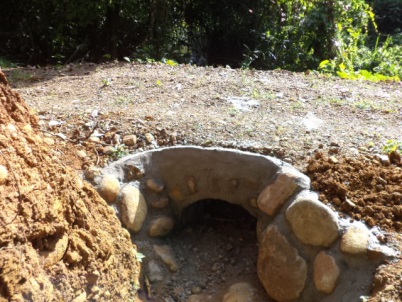

NEW JAIPUR COW PROTECTION BEGUN WITH THREE LOCAL COWS
For 5 years we have made various attempts in starting our cow protection program here. First we tried to find a decent non-Freisan dairy cow from an operating dairy on Viti Levu- but the brucellosis epidemic and their poor quality stock was discouraging. The government brought 300 dairy cows from Australia, but they were unavailable to us. There are no pure Jersey, Guernsey, Brown Swiss, or Ayrshires in Fiji, all cows are mixed. We lined up 6 Guernsey calves from Australia, but the cost by boat was sky-high. New Zealand was closer, and we found a direct flight to could carry heifers up to a certain size. NZ Guernsey Association agreed to sell 5 calves and a pregnant heifer- photos were sent, tests done, deposit made, but at the last minute Fiji Biosecurity put an indefinite halt on ALL animal imports from ANYWHERE. We looked into import of frozen Guernsey embryos- but costs, risks, and arrangements were still daunting.
Five years; no progress. One day I was in Labasa supply shopping- I brought a Jersey cow photo and began to ask people at random, “Have you seen this cow?” Most answers were negative, but finally two men at the hardware said I should see Kalim at a certain fish company. I did, and trying to ignore the stench of dead fish, Kalim confirmed that he had pure Zebu, Brahman, and mixed Jersey Zebu cows. We agreed to meet at his farm the next day. Hopeful, on the way home I spotted the characteristic face of a Jersey on the roadside. Screeching to a halt, I observed a mixed Jersey with the Zebu long nose. I found the owner Rakesh at home with his trailer full of sugarcane. The cow was mixed with Brahman, an A2 Indian Zebu crossbreed used to upgrade their beef stock. It had a Jersey head, a Brahman body. Rakesh explained that the 5 month drought in Labasa (starting 2 months earlier than on our windward side) had resulted in NO grass for cows to eat. I looked around the surrounding countryside- all was barren, brown, only the trees were green above the fire-burnt, empty canefields. The drought prediction was for several more months, so without grass, he agreed to sell, although it was their family milk cow, and their good luck, having been born on Diwali… I visited their small communal temple building with Ganesh, Lakshmi, Shiva, Rama, Krishna, and Durga. Choose your favorite deity… I told him I would let him know soon.
That evening we pondered these new developments. Somehow Krishna had not sanctioned our plans to bring overseas cows. In hindsight, it was too costly and perhaps an over-endeavour. Starting with a few local cows that were almost all Jersey and Zebu, the chance of A2 genetics were perhaps 80-90%. When Jersey or Guernsey are crossed with Zebu (not great milkers, but they ARE milk cows), milk quality and quantity does not decrease- yet they are hardier animals more suited to the tropics. Dayalchandra in Hawaii crossbreeds Jersey with Zebu and results were notable and superior. Guernsey-Zebus have done well in various hot climates around the world. It would be relatively simple to bring frozen Guernsey semen in a nitrogen tank from Australia and with 2 or 3 rounds of artificial insemination (AI), we could quickly develop a top-notch Guernsey genetically-diversified milking herd with traces of Zebu and Jersey. These would be the best quality milk cows in Fiji (local government & dairies are fixated on Freisan A1 cows). Our cows could be called ZEBSEYS…
AI is a simple but artificial procedure, to be employed only temporarily to reach to achieve a useful, pro-ductive milk cow herd. The effects of Kali Yuga in Fiji have almost made the milk cow extinct. It is an urgent situation, how to preserve the milk cow species. It might be argued that AI is unnatural. We agree, but unnatural degradation of the milk cow by beef breeding requires adjustment if we are to actually succeed in living naturally by the grace of the land and cows. Otherwise, it may be the demise of milk cows ! “Cows” giving useless watery “milk” (no butterfat: no ghee) are perhaps not milk cows at all…
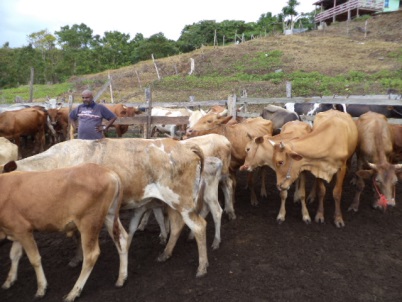

ABOVE: Talim’s Zebu/Brahman beef cow farm, Rakesh’s Brahman/Jersey bull (father of Lakshmi’s calf)
So the next day I chose two unbred heifers from Talim, amongst his starving herd of 73 animals. Daily he brings cane tops, coconut meal and molasses to keep his cows alive, and cuts branches of leaves from trees, as his cows hungrily scrounge the barren hillsides for tiny pieces of grass. We arranged a truck, loaded the two Jersey-Zebus, and then went to pick up Rakesh’s adult cow who is four months pregnant with his Brahman/Jersey bull. After a 3 hour harrowing ride over the mountains (never rent a truck with a slippery steel floor), and the three cows falling over each other, we arrived after dark in a heavy drought-breaking rain. The cows were bewildered by the 3 foot high batiki grass, but by the next day they were contentedly grazing in Grass Paradise, otherwise known as New Jaipur. We named them Lakshmi, Padma, and Tungi. Soon they learned how to drink from the river, but as yet they have no interest in scrap vegetables or fruits. To everyone, we explain the principles of cow protection, and this preaching leaves deep impressions on their minds, as they reconsider cultural norms of cow killing and meat eating. Our example is the first step to uplifting human society, just as Srila Prabhupada taught us.
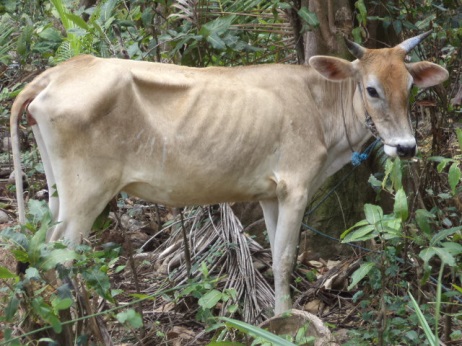
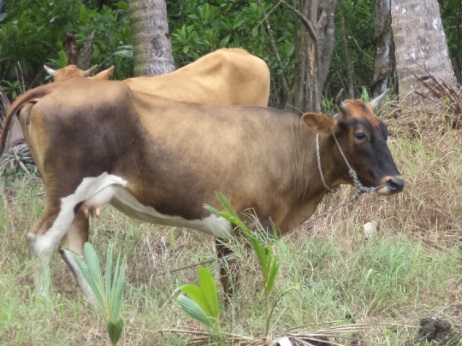
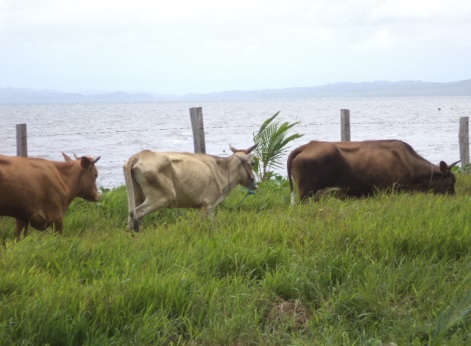
ABOVE: Padma (very skinny but recovering), Lakshmi (pregnant 4 mo’s), Tungi (in rear) & on the beach
WORLD DEFLATION AND THE GREATEST DEPRESSION
From a lifetime of business and the amateur study of economics, and taking a special interest in the “credit crisis” since 2007, I am now confidently of the opinion that the world faces an immediate and unavoidable financial upheaval and deflationary collapse of credit. Everyone expects inflation, but if $50 trillion of central bank infusions into the system since 2008 has not yet produced inflation, WHAT WILL? The forces of deflation are overwhelming inflationary forces and have gotten the upper hand. We are not in a Weimar Republic scenario of printing actual paper money; the monetary expansion of today is largely an increase in electronic DEBT, not of paper money in circulation. This overall debt load can no longer be serviced, resulting in default, restructuring, liquidation, asset shedding, bankruptcy, and shortage of cash. Some things are still inflating, e.g. food, but if one looks closely, practically everything else, namely secondary stock indices, general commodities, foreign currencies, bonds, real estate (now even London & New York) – all have markedly declined in value. The 2007-09 episode was a warning that the end of hundreds of years of financial expansion has reached its ultimate sustainable limit. The lies of official statistics and central bank bluffing cannot remedy the underlying disease of over-borrowing from the future. The age of easy money and inflation is over; a new reality has arrived, and although I may be wrong, my two-cents of unsolicited advice is that devotees everywhere should do the following:
1. Eliminate secured debt as much as possible lest it cannot be serviced and there is default
2. Be prepared to withdraw your cash from the banks before they disallow or restrict this (I know a devotee who lost big-time with the Cyprus banking “bail-in”)
3. Precious metals are in a long-term downtrend & are most likely going MUCH LOWER, so don’t use metals as an inflation hedge when they are declining in dollar terms
4. Liquidate for cash all unnecessary possessions while there are still ready buyers
5. Take steps now towards self sufficiency, and have your options ready or in place
Most everyone expects the death of the US dollar and gold/silver going to new heights. However, because two thirds of the world’s debt and contracts are in USD (a status that will not change quickly despite publicity about BRIC’s increasing avoidance of dollar use), as the pressure to salvage one’s assets increases by paying off debt to avoid default, demand for the USD will increase relentlessly. The USD is far above its lows of years ago and has clearly established its uptrend.
The dollar is not dying yet, although in a few years, after a complete equalization of debt by deflation, then probably hyperinflation will follow due to actual massive cashnote printing. Precious metals are not going up, the economy is NOT improving, real estate languishes far below former highs, and most commodities are in downtrends. The theory of inflation is negated by what is actually occurring- it may seem counterintuitive, that in the face of unprecedented credit expansion, still the economy is slowing and falling. At a certain point, further increase of debt CAUSES deflation instead of inflation, as defaults destroy existing debt faster than it can be created. It takes willing and capable lenders and borrowers to expand the economy, but when there is no will to lend (banks are just parking their funds) and no will to borrow (people cannot afford to), the debt pyramid collapses as defaults spread. The financial house of cards today can collapse within a few days, at best a few years. Life as we know it will cease to exist !
This discussion may seem a little off-topic for VVR, but if devotees lose everything, residence, income, and cannot access savings, it becomes difficult to spread Krishna consciousness due to being so inconvenienced ourselves. Please consider the deflation scenario carefully and hopefully this note of caution and steps to take will be useful to Prabhupada’s mission and his servants. Be prepared, be safe; times are dangerous, risk should be avoided. We should preserve what we have, not put it at risk in hopes of a continuation of the inflationary environment that has ended. Now cash is king, debt is a death-knell. To me it appears that the modern civilization is self-destructing- by war and an economic depression far worse that the 1930’s, lasting past our children’s lifetimes. The existing financial system is totally artificial and is an illusion only. The next major episode in the history of the world is a massive neutralization of debt. The godless snake is eating its own tail. My apologies if I am proved wrong.

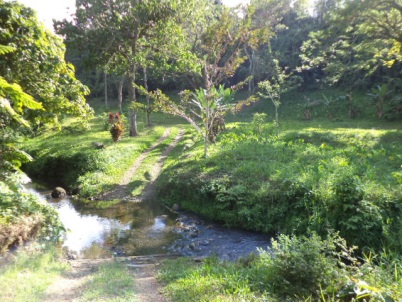
ABOVE: SriGovinda’s 2011 last will and testament, river crossing midway down valley from main road
PLANTS WANTED LIST, MOST PROPAGATED FROM SEEDS: with subjective ratings 1 to 5
The following list is of plants from which we are looking to get seeds. If anyone can help with this, please contact us, as it would be a major contribution to our food supply for the village project and our preaching by demonstrating how many wonderful foods Krishna has provided us (why kill animals?)…
1-ABUI (Brazil- We have one that survived, and some seedlings, apple sized, delicious)
1-ACACIA KOA (Hawaii, beautiful huge fast-growing, furniture wood)
5-ACEROLA (SURINAM CHERRY, PITANGA, high Vitamin C, but can be invasive)
2-AKEE (poisonous immature; sickening over-ripe; otherwise delicious, high protein; often cooked)
2-ALLSPICE (pimento dioica, spice tree, Jamaica)
1-ATEMOYA (hybrid of Cherimoya/Sugar Apple- widely appreciated fruit)
2-BARBADOS CHERRY (Malphighia glabra, W Indies, two crops/yr, one inch bright red, tart to sweet)
3-BIGNAY (clusters of small grape-like fruits, more sour than sweet)
1-BLACK SAPOTE (green skinned, black chocolate pudding flesh)
1-CALOMONDIN ORANGE (Citrus mitis, more tart but similar to kumquat, lime taste, edible skin)
1-CAMPHOR (Cinnamomum camphora, large tree, camphor oil and gum made by distillation)
2-CANISTEL (YELLOW SAPOTE, Lucuma nervosa, orange flesh, oval, several similar varieties, 3 inch fruits)
4-CARISSA (NATAL PLUM, South Africa, 1-2 inch fruits, strawberry taste, jams or fresh with sugar)
1-CASHEW (gives yellow or red fruits plus cashew nuts, young leaves edible, medicinal tree, we have 1)
1-CHEMPEDAK (SE Asia, makes saffron dye, more fruits than its relatives, breadfruit & jackfruit)
2-CHERIMOYA (CUSTARD APPLE, Annona reticulate, eat fresh or blend with milk, etc)
3-CIRUELA (Bunchosia armeniaca, Florida, S. America, small trees or shrubs, sweet peanut butter taste)
1-CLOVE (Spice tree, good for toothache)
4-COCOPLUM (ICACO, tropical America coastal shrub/ small tree with round 1 inch fruits, jams)
2-DURIAN (seeds short-lived, skin has offensive odor, highly tasty & nutritious, cooked seeds edible)
2-FEIJOA (PINEAPPLE GUAVA, lovely fresh fruit)
1-FIG (Ficus carica, most require cold periods, some varieties prosper in tropics like Bahamas)
2-GANDARIA (Malaysia, small mango-like fruits, prolific, sweet-sour taste, new leaves edible)
3-GENIPA (GENIPAP, Puerto Rico, Brazil, orange-sized brown fruits, like dried apple taste, green dye)
2-GRANADILLA (we have some which are tasteless, looking for seeds from superior varieties)
2-GRAPES (is there a sweet variety suited to wet tropical climate, a non-hybrid heritage variety?)
1-ILAMA (Annona diversifolia, the lowland Cherimoya, best of the Annonas, smaller trees )
3-IMBE (Garcinia livingstonei, ornamental tree, Africa, fruits small, juice stains)
3-IMBU (Spondias tuberosa, wild in NE Brazil, small green plum-like fruit, prolific)
2-JABOTICABA (Brazil, delicious dark purple grapes grow on trunk and main branches)
1-JACARANDA (So Amer, Hawaii, breathlessly beautiful lavender blue flowering tree)
4-JUJUBE (better as cuttings from proven trees, thorny, India/Malay variety better than Common/China)
1-KADAMBA (India, rare flowering tree)
1-KIKUI NUT (CANDLENUT, Aleurites moluccana, Hawaii, Malaysia, nuts make oil, many uses from tree)
1-KIWI (Vines, propagated by cuttings I think, but would need a hardy variety, not ultra-hybrid)
1-LEMON (want heritage, non-grafted varieties: have West Indian, Seedless, local rough lemon)
2-LONGON (we have only one tree, propagated by seed, relative of lychee, want more varieties)
2-LUCMO (LUCUMA, Lucuma obovata, Peru, ancient fruit 3 inches roundish, yellow flesh)
A1-LYCHEE (one of the best fruits, we have 4 or 5, live well over 100 years, slow to start but prolific) 1-1-1-MABOLO (VELVET APPLE, BUTTERFRUIT, Philippines, related to persimmon, eaten fresh or cooked)
1-MACADAMIA (a nut tree, double shelled, we have a few but interested in other varieties)
1-MAMEY SAPOTE (Latin America, pink/orange flesh, very nice, lg trees w/fragrant white flowers)
1-MAMONCILLO (Melicoccus bijugatus, Cen America, like little limes, not the Mamonchino/rambutan)
1-MARANG (small superior quality jackfruit from Philippines)
MOMBINS:
3-RED MOMBIN (Spondias mombin/purpurea, tropical Americas, improved varieties best, large tree)
4-YELLOW MOMBIN (Hog Plum, Spondias lutea, W. Indies, large tree, red mombin is better)
2-OHIA LEHUA (ornamental, good timber, Hawaii)
2-OTAHEITE GOOSEBERRY (Cicca disticha, Tahiti, SE Asia, pretty tree, profuse clusters, tart, up to 1 inch)
2-PAPERBARK (CAJEPUT TREE, ornamental, medicinal, Australia & Hawaii)
1-PERSIMMON (some varieties are suited to tropics, top-notch fruit)
2-PITAYA (Hylocereus undatus, climbing cactus, nice fruit & night flowers)
1-POMEGRANATE (we have 8 red ones doing poorly, but other varieties better in tropics; need training)
3-POSH-TE (Annona scleroderma, thick shell)
2-PULASAN (SE Asia, similar to Rambutan, but larger, more bumpy than hairy)
2-RAINBOW EUCALYPTUS (would like a few just for ornament)
1-RAMBUTAN (We have 8 struggling specimens, local bugs eat the leaves; hope for other varieties)
1-SAPODILLA (CHICO, NASEBERRY, NISPERO, longlasting seed, we have 12 trees, want other varieties)
2-SONCOYA (Annona purpurea, orange flesh, large fruit tasting like papaya)
2-SNAKEFRUIT (SE Asia, trunkless palm, nutritious sweet-tasting fruits that keep for months)
2-STAR APPLE (we have two trees, would like more variety, purple skin, white flesh)
1-SUGAR APPLE (SITAPHAL or SWEETSOP, Annona squamosal, Sita’s fruit, few seeds)
4-TROPICAL ALMOND (Terminalia catappa, hardy salt tolerant, Indian variety best for edible nuts)
4-UVALHA (Brazil, small tree or shrub, Eugenia uvalha, one inch fruits, acidic, great for drinks)
3-WAMPI (Clausena lansium, grape-like, So China, ornamental tree)
3-WAX JAMBU (JAVA APPLE, Syzygium samarangense, SE Asia, similar to Mountain Apple)
2-WHITE SAPOTE (short-lived seeds, most give inferior fruit, superior grafted varieties are delicious)
WE ALREADY HAVE IN NEW JAIPUR:
4-AMBARELLA (Spondias cytherea/dulcis, “Wii” in Fiji, spiny seeds, less tasty than imbu/red mombin)
2-BAEL (India, we have some, edible fruits, medicinal, soap, dye, cement additive, fragrant flowers)
4-BILIMBI (SE Asia, very sour, medicinal, garnish, pickles, juices, we have 1 or 2)
1-BREADFRUIT (we already have several varieties, locally propagated, often part of our meals)
3-CHAYOTE (Sechium edule, Mexico, vegetable pear on vines, cook or sliced with sauce-here locally)
2-CINNAMON (we have quite a few already)
1-CITRUS (we have many types: lime, lemon, grapefruit, kumquat, mandarine: all are grafted varieties)
3-GUAVA (we have two varieties)
1-HONG KONG ORCHID (Bauhinia, ornamental, we know of one locally from which we will get seeds)
1-JACKFRUIT (we have 7 or so, will get our own seeds soon)
1-KUMQUAT (We have some sour & sweet varieties, grafted or heritage)
2-LANGSAT (we have a dozen 4 year old trees 15+ feet high, loved in Asia)
3-LOQUAT (most seedlings are inferior, best grafted, for jams, best at 3000+ ft elevation)
2-MALABAR CHESTNUT (edible nuts, tastes like peanuts, high in oil & fat- we are growing 65+ seedlings)
1-MANGO (Most varieties need dry season- we don’t have one- plenty local varieties to try though)
1-MANGOSTEEN (we have about 10, now 4 yrs old, true to seed, so we’ll see how the fruit will be)
2-MONKEYPOD (RAINTREE, huge shade trees, we have them up & down the valley)
2-MOUNTAIN APPLE (Syzygium malaccensis, KAVIKA is local name, wild here in Fiji)
1-NUTMEG (we have a few trees, also a native tree MAKITA, with less spicy nuts)
1-PAPAYA (We have plenty, Hawaiian type also available locally, large variety still missing though)
1-PASSION FRUIT (We have them, plentiful locally)
1-PINEAPPLE (we have 1000+ in 2 local varieties)
1-PLANTAIN (have Musa sapientom, but slimmer Musa X paradisiaca not here; propagate by root bulbs)
3-RAMONTCHI (GOVERNORS PLUM, acidic fruits make jams, shrub or small tree)
3-ROSE APPLE (we have 5 or so, the fruit not very luscious, but makes a great sauce)
1-ROYAL POINCIANA (decorative, FLAME TREE, we have some young trees starting to flower)
2-RUBBER TREE (Ficus elastic, found locally, very large, produces rubbery gum)
1-SHOWER TREES (comes yellow or pink, we have both, ornamental)
2-STARFRUIT (CARAMBOLA, we have many mature sour variety, 2 sweet ones)
2-SOURSOP (GRAVIOLA, very healthy, a little trouble with the seeds, but tasty; already have these)
1-TAMARIND (we have plenty specimens, from both local and Philippine seeds)
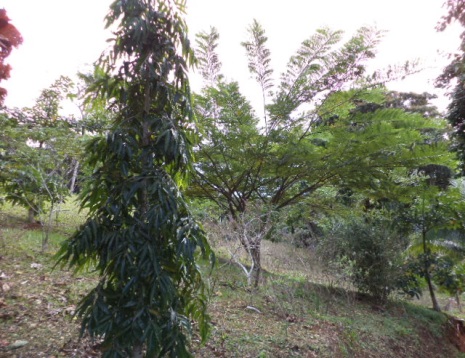
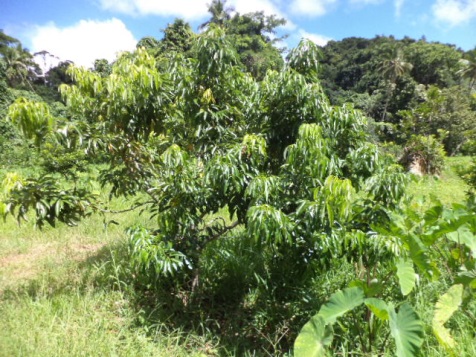
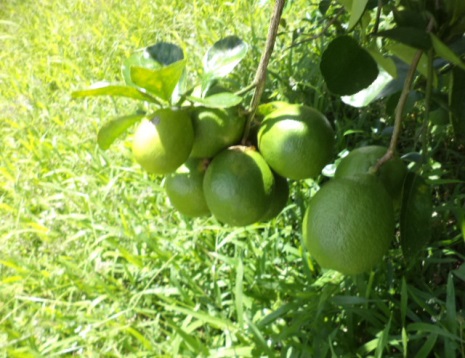
ABOVE: 1. Ashoka w/pink shower tree in rear 2. Lychee tree 3. Meyer lemons bear on/off year-round
THESE ARE REJECTED DUE TO VARIOUS REASONS:
1-DATES (wonderful fruit but needs quite dry climate, unless there are wet climate varieties?)
3-GREEN SAPOTE (Calocarpum riride, limited to elevations over 3000 ft in tropics; we are at sea level)
5-JAMBOLAN (JAVA PLUM, tart, invasive tree)
4-KEI APPLE (So Africa, thorny hedge good for fencing, fruits good for preserves, jams)
4-KETEMBILLA (CEYLON GOOSEBERRY, small thorny tree good for hedges, fruits as jams)
3-OPTUNIA (PRICKLY PEAR or TUNA, cactus, but only for dry climates)
1-PEARS (require cold dormancy, but some varieties might do well here?)
5-STRAWBERRY GUAVA (tasty fruits but an invasive species, curse in Hawaii)
FARM QUOTES FROM PRABHUPADA
►760803r3.par Conversations
Prabhupada: So show the simple example that how by simple living and thinking of Krsna, one can become perfect and happy.
►760812mw.teh Conversations
Prabhupada: No, that work is recommended. Your question is how Krsna is giving you instruction. Just like food, Krsna says annad bhavanti bhutani. You produce anna. Krsna never said that you produce
tire tubes. Never says…
►760610r3.la Conversations
Prabhupada: All fresh vegetable, fresh milk, this is celestial. Who has got the opportunity in the city?
►701221rc.sur Conversations 324679/530501
Prabhupada: That means the social structure is very bad. Otherwise, natural procedure is that everyone should be self-independent. But why state has to give them help? That’s not good. You may be… Just like a son may be very rich man’s son, but if the father provides him only, then he’s a useless son. Is it not? If the father has to provide him money for his maintenance, then that son is useless son. That is not a good certificate. Although you may be very much proud that “I am maintaining my so many sons,” why you should maintain? Let them be self-supported.
Yadubara: But what can the state do? Should the state just leave the people alone?
Prabhupada: No. They should make the citizens so nicely developed in their Krsna consciousness that they should be self-dependent, self-satisfied. That is the ideal of civilization.
►Letter to Rupanuga, Bombay, 18 December 1974
Our farm projects are an extremely important part of our movement. We must become self-sufficient by growing our own grains and producing our own milk, then there will be no question of poverty. So develop these farm communities as far as possible. They should be developed as an ideal society depending on natural products not industry. Industry has simply created godlessness, because they think they can manufacture everything that they need. Our Bhagavad-gita philosophy explains that men and animals must have food in order to maintain their bodies. And the production of food is dependent on the rain and the rain of course is dependent on chanting Hare Krishna. Therefore let everyone chant Hare Krishna, eat nicely and keep their bodies fit and healthy. This is ideal life style. We do not condemn modern civilization but we don’t like to get it at the cost of God Consciousness, that is suicide. Your farm in Pennsylvania sounds very nice.
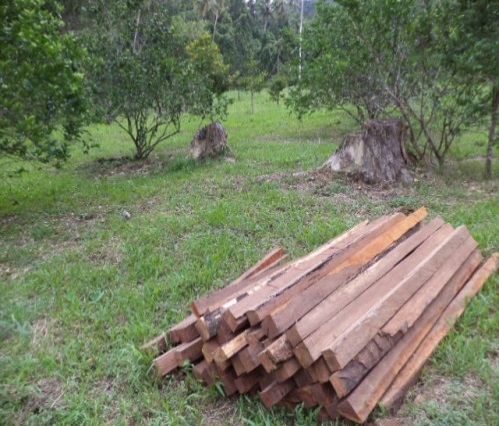
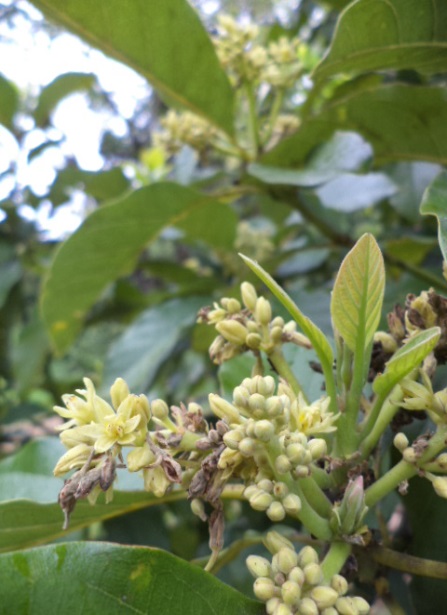
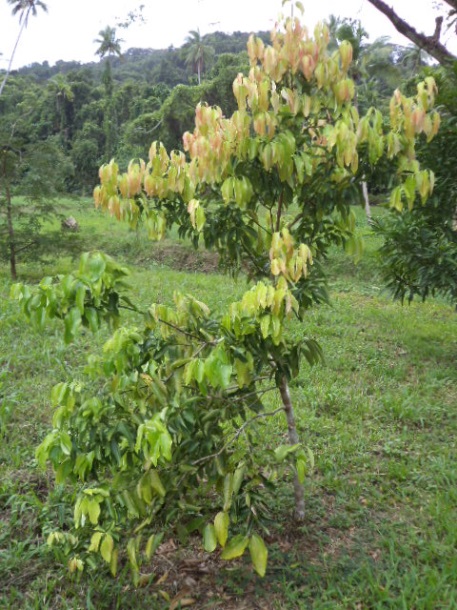
ABOVE: Some of 400 new fence posts, avocado blooms (only a few will fruit), cinnamon tree new growth
SUMMARY
New Jaipur is a positive alternative to the rapidly devolving situation in the modern civilization. Nuclear war approaches, and humanity is due for much turmoil which can only be alleviated by establishing Prabhupada’s varnashram Hare Krishna farms. Our Vedic Village farm project retains Srila Prabhupada as the sole diksa guru, via rtvik representatives. As an affiliate of the Hare Krishna Society, we are part of Prabhupada’s transcendental ISKCON which is situated beyond the now-corrupted original institution. There are 857 acres of titled, fully-paid land in a pristine South Seas rainforest environment on Vanua Levu, Fiji’s second largest island. We have openings for a few qualified devotees based on adherence to certain conditions as contained in our Village Constitution (available by email). For someone who might like to participate in a Prabhupada Vedic Village- please inquire. One must chant 16 rounds daily, follow the four rules, visit the project, followed by an agreement of participation. There is no cost but 8 hours community service a week, regular attendance to the morning program, and to become a productive participant, one fifth going to the deities, Sri Sri Radha Govinda. Vedic villages are the future of the world.
Yours in Prabhupada’s service,
Nityananda das
If you would like to be added to our regular mailings of Vedic Village Review news bulletins, please send us an email at srigovinda@gmail.com. Hare Krishna! All Glories to Srila Prabhupada!
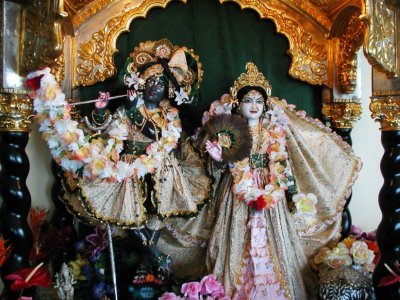







Speak Your Mind